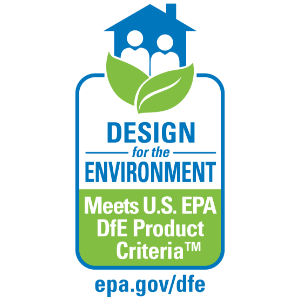As shown in the table above, citric acid:
• Is not a carcinogen—nor is it likely to have endocrine disruptor properties.
• Does not cause reproductive issues—nor is it likely to cause developmental, mutagenic, or neurotoxicity issues.
• Is not a skin or lung irritant—nor does it have any unresolved or unreasonable adverse effects.
• Is not toxic to aquatic life.
• Does not break down slowly in the environment or accumulate in humans and other species.

Further, each of these active ingredient safety and health assurances also extends to all of GE Fight Bac RTU’s inactive ingredients, which—along with its rating in the lowest EPA toxicity category—have qualified GE Fight Bac RTU for the EPA’s Design for the Environment (DfE) label for use on antimicrobial products, like disinfectants and sanitizers.
This label is intended to help distributors and end users identify products that are proven safer by meeting the program’s stringent requirements and high standards. Currently, there are only 11 disinfectants that have qualified for DfE certification,
less than half of which appear on EPA’s List N and are approved for use against SARS-CoV-2
(the virus that causes COVID-19).
In fact, GE Fight Bac RTU and its ingredients are so nonhazardous that this product scores 0 for every category on the Hazardous Materials Identification System (HMIS) scale*!
• Minimal Health Hazard: The slash in the left box indicates that the chemical does not cause chronic health problems, and the 0 in the right box that these chemicals cause little or no significant acute health risk. This category
includes chemicals that are basically nonirritating to the skin and eyes.
• Minimal Flammability Hazard: These chemicals will not burn when exposed to a temperature of 1500 degrees F for a period of 5 minutes.
• Minimal Reactivity Hazard: These are chemicals that are normally stable, even under fire exposure conditions, and are not reactive with water.
• Furthermore, no special technical protective measures are necessary,
which is why the white box at the bottom usually reserved for PPE is blank. |  *HMIS is a voluntary hazard rating scheme to aid employers and employees in day-to-day compliance with the U.S. Occupational Safety and Health Administration's (OSHA) revised Hazard Communication Standard (HCS). It includes a rating system for acute and chronic health, flammability, and physical hazards, with ratings based on a 0–4 scale: 0 represents minimal hazards or risks, and 4 represents significant hazards or risks. |
2. It's Effective
GE Fight Bac™ RTU is a hospital-grade disinfectant that kills 15 viruses and bacteria in just 3 to 5 minutes, saving on time and labor costs.

In 3 minutes, kill Hepatitis B and C and the common cold.
• Pseudomonas aeruginosa
• Salmonella enterica
• Staphylococcus aureus and MRSA
• Aids Virus
• Influenza A virus
• Feline Calicivirus
Plus, in 60 seconds, sanitize food contact surfaces against Staph and E. coli. GE Fight Bac RTU is also tuberculocidal, meeting OSHA’s Bloodborne Pathogen Standards.
Because it has demonstrated efficacy against harder-to-kill feline calicivirus, citric-acid-based GE Fight Bac RTU is recommended by the EPA for use against SARS-CoV-2 under the emerging viral pathogen policy.
All the various viruses and bacteria that GE Fight Bac RTU is proven effective against are listed in the table on the right.
3. It's Versatile

Because GE Fight Bac RTU is free from harsh chemicals, it can be used:
• As a food contact sanitizer with no rinsing or wiping required.
• In sensitive environments—such as day care centers.
• On sensitive surfaces without leaving damage, streaks, or residue.
A more complete listing of surfaces on which and areas in which GE Fight Bac RTU can be used are summarized in the table on the right.
GE Fight Bac RTU is also versatile when it comes to application methods, because package sizes range from quart bottles, gallon bottles, and 5-gallon pails all the way up to 55-gallon drums and 275-gallon disposable totes. The quart bottles come
with a trigger sprayer for immediate use, and the larger package sizes can be used to fill:
• Pump-up sprayers
• Electrostatic handheld sprayers, backpack sprayers, and carts
• Airless sprayer floor units and carts
4. It's Available
Quaternary ammonium compounds—often referred to as simply “quats”—are the active ingredients in most disinfectants. In the U.S., the 3 main producers of quats create them by reacting alkyl halides with tertiary amines—the
latter of which are made from ammonia and alcohols. An explosion in demand for quat-based disinfectants due to the COVID-19 pandemic, coupled with related challenges regarding importation of necessary raw materials from usual international
sources, has led to quat shortages.
As a result, alternative disinfectant active ingredients are gaining traction in the industry, such as citric acid, GE Fight Bac™ RTU’s active ingredient. Citric acid is found naturally in citrus fruits, particularly lemons and limes,
and is currently much easier to source than quats.
Because citric acid is abundantly available at the present moment, Betco is running a promotion on 55-gallon drums of GE Fight Bac RTU through the end of July. To learn more and begin leveraging this citric-acid-based disinfectant as a sustainable
alternative to quat-based disinfectants, please click here.